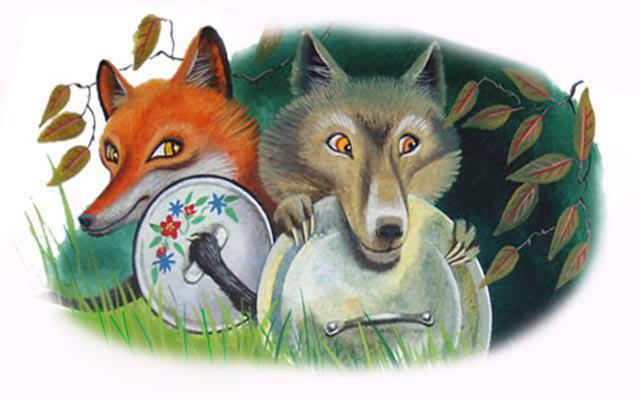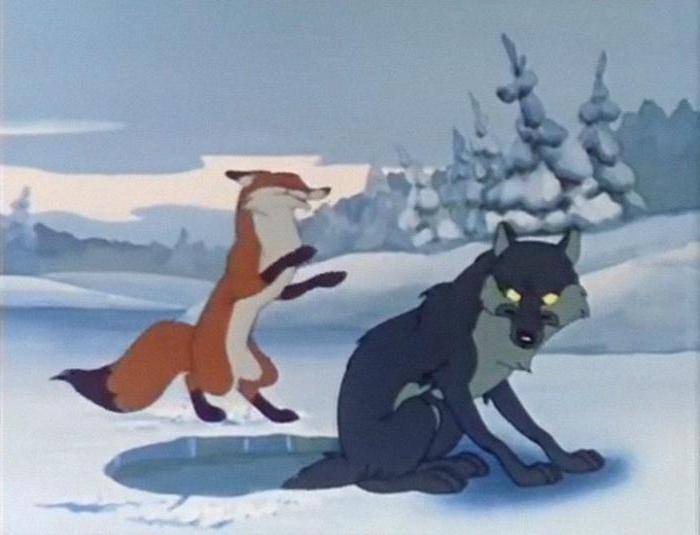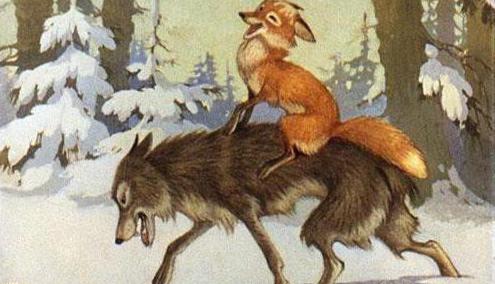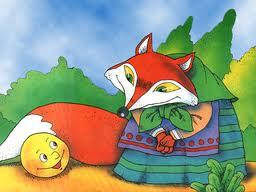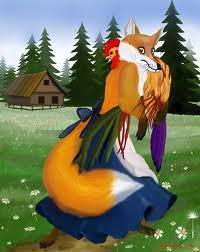Русские народные сказки известны не только детям, но и взрослым. Каждому из нас читали на ночь поучительные истории о людях и животных. Сказка «Лиса и Волк» написана в привычном фольклорном стиле, в ней соблюдены традиции русского народного повествования.
Хитрая «шуба»
Эта забавная история повествует нам о доверчивом волке и находчивой лисе. Свою хитрость плутовка проявила уже с первых минут.
Сказка «Лиса и Волк» начинается с того, как дед с бабкой решают полакомиться рыбкой. Для этого старик отправляется на реку за уловом. Поймав целую телегу рыбы, он возвращается домой. Вдруг его взору предстает мертвая лисица, свернувшаяся калачиком у дороги. Радости старика не было предела: теперь он не только угостит бабку рыбой, но и воротник шикарный привезет! Положил он находку в телегу и поторопился домой. Но не тут-то было. Плутовка оказалась живее живых! Мало того, еще и дедкину рыбу всю съела. Вернувшись домой, он с удивлением обнаружил, что «воротник» исчез. А с ним и рыба пропала.
Вот какой мы впервые встречаем нашу рыжую хитрюгу.
Сказка «Лиса и Волк» учит нас тому, что не стоит так сразу доверять своим глазам. А еще чудеса случаются не так часто, как хотелось бы.
Доверчивый волк
На этом проделки лисы не заканчиваются. Сидит она, украденную у деда рыбку доедает. Пробегал мимо волк, увидал лису и попросил угостить ее. Но наша плутовка не так проста! Не захотела она добычей делиться. И снова она идет на обман: предлагает волку самому на рыбалку сходить. И не просто на удочку, а на хвост в проруби половить, да подольше. Волк не понял ее издевки, оказался слишком доверчивым, за что и поплатился. Сидит он, мерзнет, хвост в прорубь опустил и приговаривает, чтоб ему и большая, и малая рыбка попалась. А рядом с ним плутовка бегает, да шепчет, чтоб мороз покрепче был. Целую ночь пришлось глупому волку так сидеть. Утром решил собрать улов, а встать не может! Подумалось ему, что это добыча у него великая. Но тут на его беду шли женщины за водой. Увидев такого зверя, стали они его колотить и прогонять. Насилу он, бедный, ноги унес.
Смысл сказки «Лиса и Волк» прост: среди друзей могут оказаться хитрецы. Стоит подумать и все взвесить, прежде чем слепо верить словам другого человека.
И снова обман
Но и после этого хитрая не жалеет своего товарища. Оказалось, что пока волка били из-за ее советов, лиса пошла воровать блины, да угодила головой в тесто. Бежит она навстречу волку и причитает, что ей плохо. Волк начал жаловаться, что получил после ее подсказок. Но лиса оказалась хитрее и повернула ситуацию в свою пользу. Наговорила ему, что ее тоже всю избили. Да так, что мозги потекли. Наш наивный герой и на этот раз поверил плутовке.
Сказка «Лиса и Волк» продолжается тем, что побитый бедняга посадил себе на спину хитрюгу и повез. Ей бы радоваться, а она еще и издевается. Сидит на волке и нашептывает, что битый волк ее небитую тащит. Переспросил он, что такое подруга тихонько говорит, а она его обманывает, что жалеет их, поколоченных.
Вывод
Чему же учит нас эта история? Во-первых, быть умнее. Не раз волк попался на удочку своей приятельницы, но так и не заметил подвоха. Дети, читая эту сказку, конечно, жалеют серого. Но все, что с ним происходит, довольно предсказуемо. Неизвестно, сколько раз он еще попадет на ее удочку.
Доверяй, но проверяй — пословица выражающая смысл сказки «Лиса и Волк».
В общении с людьми нужно быть предусмотрительнее и всегда обдумывать свои действия. Возможно, если бы волк не был так глуп, то понял бы, что никто на хвост рыбу ловить не пойдет. А когда мозги из головы текут, и лиса бегает при этом, серому точно нужно было догадаться о ее проделках.
Образ волка в этой сказке не совсем привычный для нас. Здесь он добрый, доверчивый. А лиса все та же хитрая плутовка!
Тема урока: «Лев, волк и лиса». Уйгурская народная сказка. Класс: 5
Цели урока: познакомить с уйгурской народной сказкой «Лев, волк и лиса»;
развивать умения правильно произносить слова и выражения из сказки, отвечать на вопросы свободно и рассудительно; делать выводы по прочитанному тексту; воспитывать умение находить выход из трудной ситуации.
Тип урока: комбинированный
Методы и приемы: беседа, чтение с остановками.
Наглядности: презентация
Ход урока:
I.Организационный момент
ІІ. Опрос д/з (пересказ сказки «Заработанный рубль»)
ІІІ. Актуализация знаний
Чтение загадок. Разгадайте загадки.
Грозный очень и отважный,
Гривой он могучей машет.
А рычит, как на распев –
Это сильный, храбрый…
(Лев)
Серый гонится за белым,
Хочет белым пообедать.
Как догонит — зубом щелк:
Белый — бедный, сытый — …
(Волк)
Хвост пушист, быстра сноровка,
Золотисто-рыжий мех.
Если голодно, плутовка Кур считает лучше всех.
(Лиса)
-Ребята, дайте характеристику льву, волку и лисе.
ІҮ. Объяснение нового материала.
Сказки о животных встречаются в фольклоре любого народа. Существуют они и в русской традиции.
Лев — это хищник из рода пантер, подсемейство больших кошек. Этот красивый зверь имеет второе место в отношении собственной величины по сравнению с другими большими кошками. Лев Не зря в сказках лев олицетворяет царя, ведь действительно он имеет царские повадки, величественную походку.
Среди персонажей этих сказок особое место занимает волк.
Волк в сказках традиционно олицетворяет собой жадность и злобу. Его часто изображают глупым, поэтому его часто одурачивают персонажи сказок похитрее, например, Лиса. Противопоставление этих двух сильных животных характеров встречается во многих сказочных сюжетах, и почти во всех волк, являясь недогадливым и недальновидным, снова и снова дает себя обмануть. Однако, в древних культурах образ волка ассоциировался со смертью, поэтому в сказках этот животный персонаж зачастую кого-то съедает («Волк и семеро козлят») или нарушает спокойную жизнь животных («Зимовье зверей»). Но в итоге добрые сказочные персонажи русских сказок всегда обманывают или побеждают волка. Например, волк в сказке «Лисичка-сестричка и волк» остается без хвоста.
— Часто ли вы встречаете в сказках лису?
-Нравиться ли вам образ лисы в сказках?
-Каким героем она чаще всего выступает?
-Что вы знаете об этих животных?
-Кому из вас, не рассказывали сказки, где одной из главных героинь была лиса? Наверное таких людей просто нет. В сказках лиса всегда выступает, как хитрая красавица, задумавшая съесть зайца или курочку. И сказки не далеки от истины. А какие сказки о лисе вы знаете?
Сказочная лиса — это воплощение хитрости и изворотливости. Существует целая плеяда сказаний, где рыжая обманщица проявляет чудеса ловкости и умения обманывать. «Лиса-повитуха», «Лиса-исповедница», «Лиса и тетерев», «Волк и лиса» и другие. Лиса в сказках о животных особенно любит издеваться над волком. Она его учит ловить рыбу, шьет ему шубу, делает похожим на красивую птичку. Естественно, ничем хорошим лисьи проделки для волка не заканчиваются. Однако к персонажам, которые не желают ей зла, лиса может быть добра и ласкова. Выйдя замуж за кота в сказке «Кот и лиса», плутовка кормит мужа, правда, используя хитрость. А в сказке «Снегурушка и лиса» лисичка вообще становится спасительницей заблудившейся в лесу девочки. Снегурушка не доверяет ни волку, ни медведю проводить ее до дома. Не отказывает девочка только лисичке. Да и как можно отказать такой рыжей красавице?
Какова лиса в народных сказках?
— Почему называют хитрой
-Как называют её в сказках
— Почему?
В животном мире сказок существует особый тип героя – трикстер, плут и обманщик. Лиса в сказках выступает главным трикстером. Это устойчивый образ, в котором доминирует хитрость, склонность к обману и уловкам. Лиса пойдет на всё, чтобы получить своё – будет притворяться слабой и беспомощной, пускать в ход всё своё обаяние и красноречие. В русских сказках трикстеру противопоставляется персонаж-простак. Им может быть волк, которого лиса с успехом одурачивает, петух («Кот, петух и лиса»), или слабый заяц, которого она выгоняет из своей избы («Лиса и заяц»). Лиса часто наказывается в сказках. Например, Лиса в сказке «Лисичка со скалочкой» спасается бегством и прячется в нору.
Лисица — одна из самых популярных героинь детских сказок. Но как сказочный образ наделена чертами, свойственными этим животным в реальности. Лиса — символ хитрости, долголетия.
— Как вы наверое. Догадались мы будем читать сказку о животных . посмотрите, у вас в учебнике написано, что это уйгурская сказка. Что вы знаете об этом народе.
Уйгуры — тюркоязычный народ, подавляющее большинство которого живут в регионе под названием Синьцзян на крайнем западе Китая. Уйгурский язык относится к тюркской языковой группе.
Ү. Чтение сказки учителем
А) Чтение до слов: …А ты что скажешь? — спросил лев у лисы:
Б)предсказания учащихся дальнейшего события
В) Чтение продолжения сказки
6. Беседа по вопросам:
-К какому виду сказок относится эта сказка?
-Почему льву не понравились слова волка?
-Что ответила льву лиса?
-какой она показана в сказке?
-Как вы оцениваете поступки зверей?
-Нужно ли быть хитрыми?
-Чему нас учит эта сказка?
Вспомните какие пословицы, поговорки о лисе вы знаете
Волка зубы кормят, лису хвост бережет.
Сила льва не подходит лисице, хитрость лисы не подходит льву.
Лисичка всегда сытей волка бывает.
Лисой пройти – хитростью взять.
Кто в чин вошел лисой – тот править волком будет.
Лиса и во сне кур считает.
Назначили лису воеводой в лесу, – пера много, а птицы нет.
VI. Чтение казахской сказки «Лиса и коза» (внеклассное чтение).
ҮІІ.Диаграмма «Венна». Сравните обе сказки.
ҮІІІ.Домашнее задание:
Прочитать сказку стр.70-71 и пересказать.
Лев, лиса и волк

Волк и лиса последовали за могучим львом в горы. Охота удалась. Они поймали дикого быка, козу и жирного зайца. Мертвую и раненую добычу они стащили с горы в лес.
Волк и лиса очень проголодались. У них текли слюнки, когда они смотрели на свои охотничьи трофеи. Лев заметил, что их аппетит разыгрался.
«Сейчас я вам дам долю, которую вы заслужили, можете не сомневаться», – говорил он про себя. Затем, повернувшись к волку, сказал:
– Ты старый и опытный волк! Раздели между нами эти трофеи и покажи нам свою справедливость!
Волк по-своему распределил добычу:
– Дорогой лев! Пусть этот дикий бык будет твоим. Ты большой, и он большой. Коза, которая средних размеров, среднего веса, будет моей. Эй, лиса! А ты без возражений бери этого зайца! Пусть он будет твоим.
– Эй, волк, – вскричал лев, – как ты смеешь в моем присутствии говорить «это мое», «это твое»! Иди-ка сюда, осёл, возомнивший о себе невесть что!
Когда волк приблизился, лев ударил его наотмашь и размозжил голову.
Потом лев повернулся к лисе:
– Ну, давай, ты раздели по справедливости!
Лиса сказала:
– О великий лев! Пусть этот жирный бык будет тебе на завтрак! А эта коза будет господину одним из блюд обеденного стола. А что касается зайца, то он будет лишь закуской за вечерней трапезой.
Лев остался очень доволен таким дележом и спросил:
– Эй, лиса! У кого ты научилась так справедливо делить?
– У этого волка и того, что его постигло, – ответила лиса.
Умный человек тот, который извлекает урок из тех бед со смертельным исходом, в которые попадают окружающие.
Умные люди, узнав о том, что произошло с народом фараона, с племенами Ад, откажутся и от погони за богатством, и оставят свои страсти, и перестанут быть гордыми и высокомерными.
Если же они не смогут отказаться от погони за богатством, от своих страстей, останутся высокомерными, тогда уже другие будут извлекать уроки от их заблуждений.
The lion’s share is an idiomatic expression which now refers to the major share of something. The phrase derives from the plot of a number of fables ascribed to Aesop[1] and is used here as their generic title. There are two main types of story, which exist in several different versions. Other fables exist in the East that feature division of prey in such a way that the divider gains the greater part — or even the whole. In English the phrase used in the sense of nearly all only appeared at the end of the 18th century;[2] the French equivalent, le partage du lion, is recorded from the start of that century, following La Fontaine’s version of the fable.[3]
The Phaedrus version[edit]
Illustration of the fable from Francis Barlow’s edition of Aesop’s Fables, 1687
The early Latin version of Phaedrus[4] begins with the reflection that «Partnership with the mighty is never trustworthy». It then relates how a cow, a goat and a sheep go hunting together with a lion. When it comes to dividing the spoil, the lion says, «I take the first portion because of my title, since I am addressed as king; the second portion you will assign to me, since I’m your partner; then because I am the stronger, the third will follow me; and an accident will happen to anyone who touches the fourth.» This was listed as Fable 339 in the Perry Index[5] and was later the version followed by William Caxton in his 1484 collection of the Fables.[6]
The number of differing variations circulating by the time of the Middle Ages is witnessed by the fact that Marie de France included two in her 12th century Ysopet.[7] Both appear under the title «The Lion Goes Hunting» (De Leone Venante). On one occasion, she recounts, the lion is joined by officers of his court, a wild ox and a wolf, who divide the catch into three and invite their lord to apportion it. Then on another occasion, when the lion is accompanied by a goat and a sheep, the deer they take is divided into four. In both cases the lion begins by claiming portions as a legal right and retains the others with threats. In La Fontaine’s Fables there is a fourfold division between a heifer, a goat and a lamb (Fables I.6). Each of these the lion retains because he is king, the strongest, the bravest, and will kill the first who touches the fourth part.[8]
A Latin reference to Aesop’s fable is found at the start of the Common Era, where the phrase societas leonina (a leonine company) was used by one Roman lawyer to describe the kind of unequal business partnership described by Aesop.[9] The early 19th century writer Jefferys Taylor also retold the fable in terms of a commercial enterprise in his poem «The Beasts in Partnership»:
-
-
- This firm once existed, I’d have you to know,
- Messrs Lion, Wolf, Tiger, Fox, Leopard & Co;
- These in business were join’d, and of course ’twas implied,
- They their stocks should unite, and the profits divide.[10]
-
The Babrius version[edit]
In the extended Greek telling of Babrius it is a lion and a wild donkey who go hunting together, the first outstanding for strength, the second for speed. The lion divides their take into three, awarding himself the first because he is king of the beasts, the second because they are ‘equal’ partners, and suggesting that the ass runs away quickly rather than dare to touch the third. The moral Babrius draws is, «Measure yourself! Do not engage in any business or partnership with a man more powerful!»[11]
Another version that first appeared in the Middle Ages is more cynical still. A fox joins the lion and donkey in hunting. When the donkey divides their catch into three equal portions, the angry lion kills the donkey and eats him. The fox then puts everything into one pile, leaving just a tiny bit for herself, and tells the lion to choose. When the lion asks her how she learned to share things this way, the fox replies, «From the donkey’s misfortune.» This variation is given a separate number (149) in the Perry Index and is the one followed by such Neo-Latin writers as Gabriele Faerno[12] and Hieronymus Osius[13] and in English by Geoffrey Whitney.[14]
This alternative fable was given a different reading by the 13th century Persian poet Rumi in his Masnavi.[15] He began by orienting the reader to interpret the fable in a spiritual sense:
-
- Melt away your existence, as copper in the elixir, in the being of Him who fosters existence.
- You have fastened both your hands tight on ‘I’ and ‘we’: all this ruin is caused by dualism.
In Rumi’s telling, the lion had a wolf and a fox as hunting companions. The lion ordered the wolf to divide the catch and when it did so into three parts, tore off the wolf’s head, just as the lion tore the donkey to pieces in Aesop’s fable. Rumi’s speciality, however, is always to offer an explanation of his actors’ motives. In this case the lion explains that it is an act of grace for him to do so since the wolf did not recognise superiority when he saw it.
When the fox was tested in the same way, he did not even retain a morsel for himself, explaining (as in the Greek version) that he had learned wisdom from the wolf’s fate and thanking the lion for giving him the privilege of going second. This allows Rumi to conclude that we are lucky to be living now, with the examples of past generations to guide us. Rumi’s fox then worships at the feet of the lion, addressing him with the words «O king of the world» and is duly rewarded for this devotion with everything that he had resigned to the divine king.
Much the same interpretation was given to the tale by Rumi’s English contemporary, Odo of Cheriton, in the Latin work known as Parabolae. For him too the lion is a symbol of God and his actions are interpreted as an expression of divine justice. Odo explains that the lion punished the wolf, as God did Adam, for the sin of disobedience. The moral of the story is to learn from this example to show reverence to God, just as the fox learned from the wolf’s punishment. This reading of the fable therefore gained currency in Western Europe too, both via the preachers who used Odo’s book as a source of stories for their sermons and through translations of it into French, Spanish and Welsh.[16]
[edit]
There is a close family resemblance between fables where the lion takes all because he can and fables where an arbiter takes advantage of his powerful position, and indeed both are type 51 in the Aarne–Thompson classification system.[17] The 10th-century Arabic Encyclopedia of the Brethren of Purity tells one such arbitration fable, said there to be of Indian origin. Here a group of foxes are sharing a dead camel. They cannot decide how to divide it among themselves and persuade a passing wolf to make a just division. At first the wolf begins to do this, but on further consideration he decides to keep the rest for himself, as he is, after all, more powerful. (In this case, however, the foxes appeal to the lion who decides in their favour and kills the wolf and returns the camel to them.)[18]
The tale of the jackal and the otters, a 2nd-century BCE Indian sculpture from the Bharhut stupa
This fable shades into an Indian variant of the story, first told as the Dabbhapuppha Jataka,[19] which features different animals but has at its centre the same situation of an animal making an unequal division. Here a jackal offers to arbitrate between two otters who are quarrelling over a fish they have co-operated in bringing to land. The jackal awards them the head and tail and runs off with the bulk of their catch. As well as being a condemnation of the greed that leads to strife, the tale takes a sceptical view of how the powerful frame the law to suit themselves, concluding with the satirical verse,
-
- Just as, when strife arises among men,
- They seek an arbiter: he’s leader then;
- Their wealth decays and the king’s coffers gain.
In that the tale deals with outside arbitration, however, it has certain points in common with another of Aesop’s fables, The Lion, the Bear and the Fox, in which the first two beasts simultaneously attack a kid and then fight over their spoil. When they are both too exhausted to move, a fox steals their prey and leaves them to reflect, «How much better it would have been to have shared in a friendly spirit.»
References[edit]
- ^ Brewer’s Dictionary of Phrase and Fable
- ^ Merriam-Webster Dictionary
- ^ [Pascal Tréguer https://wordhistories.net/2018/05/24/lions-share-origin Wordhistories]
- ^ Fabula I.5
- ^ «THE LION, THE COW, THE SHE-GOAT AND THE SHEEP». www.mythfolklore.net.
- ^ «1.6. Of the lyon and of the cowe / of the goote and of the sheep (Caxton’s Aesop)». www.mythfolklore.net.
- ^ The Fables of Marie de France, ed. Mary Lou Martin, Birmingham AL, pp.56-8; Google Books
- ^ “The Heifer, the Goat and the Lamb in Consort with the Lion”, translated by Norman Shapiro, in The Complete Fables of Jean de La Fontaine, University of Illinois 2010, pp.8-9
- ^ The differences in interpretation between three versions of the fable is discussed in the article Societas Leonina or the lion’s share by Brian Møller Jensen, in Eranos: Acta philologica Suecana Vol. CII (2004), pp.97-104
- ^ Aesop in Rhyme, London, 1828, pp.76-7
- ^ «15. THE WOLF, THE FOX AND THE LION DIVIDING THE SPOILS (Laura Gibbs, translator)». www.mythfolklore.net.
- ^ Fabulae Centum (1564), fable 3, p.9
- ^ Fabulae Aesopi (1564), fable 78
- ^ Choice of Emblemes (1586), p.154
- ^ «Rumi: The Fable of the Lion’s Share – Journey to the Sea». journeytothesea.com.
- ^ There is a translation by John C. Jacobs: The Fables of Odo of Cheriton, New York, 1985; and a limited preview on Google Books
- ^ El-Shamy, Hasan M. (2004). Types of the folktale in the Arab world : a demographically oriented tale-type index. Bloomington, Ind.: Indiana University Press. pp. 996. ISBN 978-0-253-34447-2.
- ^ Netton, Ian Richard (2002). Muslim neoplatonists : an introduction to the thought of the Brethren of Purity (Ikhwān al-Ṣafāʼ). London [u.a.]: RoutledgeCurzon. p. 93. ISBN 978-0-7007-1466-7.
- ^ The Jataka
or stories of the Buddha’s former births, ed. E.B. Cowell, Cambridge University Press, 1895, pp.205-7, archive.org
External links[edit]
The lion’s share is an idiomatic expression which now refers to the major share of something. The phrase derives from the plot of a number of fables ascribed to Aesop[1] and is used here as their generic title. There are two main types of story, which exist in several different versions. Other fables exist in the East that feature division of prey in such a way that the divider gains the greater part — or even the whole. In English the phrase used in the sense of nearly all only appeared at the end of the 18th century;[2] the French equivalent, le partage du lion, is recorded from the start of that century, following La Fontaine’s version of the fable.[3]
The Phaedrus version[edit]
Illustration of the fable from Francis Barlow’s edition of Aesop’s Fables, 1687
The early Latin version of Phaedrus[4] begins with the reflection that «Partnership with the mighty is never trustworthy». It then relates how a cow, a goat and a sheep go hunting together with a lion. When it comes to dividing the spoil, the lion says, «I take the first portion because of my title, since I am addressed as king; the second portion you will assign to me, since I’m your partner; then because I am the stronger, the third will follow me; and an accident will happen to anyone who touches the fourth.» This was listed as Fable 339 in the Perry Index[5] and was later the version followed by William Caxton in his 1484 collection of the Fables.[6]
The number of differing variations circulating by the time of the Middle Ages is witnessed by the fact that Marie de France included two in her 12th century Ysopet.[7] Both appear under the title «The Lion Goes Hunting» (De Leone Venante). On one occasion, she recounts, the lion is joined by officers of his court, a wild ox and a wolf, who divide the catch into three and invite their lord to apportion it. Then on another occasion, when the lion is accompanied by a goat and a sheep, the deer they take is divided into four. In both cases the lion begins by claiming portions as a legal right and retains the others with threats. In La Fontaine’s Fables there is a fourfold division between a heifer, a goat and a lamb (Fables I.6). Each of these the lion retains because he is king, the strongest, the bravest, and will kill the first who touches the fourth part.[8]
A Latin reference to Aesop’s fable is found at the start of the Common Era, where the phrase societas leonina (a leonine company) was used by one Roman lawyer to describe the kind of unequal business partnership described by Aesop.[9] The early 19th century writer Jefferys Taylor also retold the fable in terms of a commercial enterprise in his poem «The Beasts in Partnership»:
-
-
- This firm once existed, I’d have you to know,
- Messrs Lion, Wolf, Tiger, Fox, Leopard & Co;
- These in business were join’d, and of course ’twas implied,
- They their stocks should unite, and the profits divide.[10]
-
The Babrius version[edit]
In the extended Greek telling of Babrius it is a lion and a wild donkey who go hunting together, the first outstanding for strength, the second for speed. The lion divides their take into three, awarding himself the first because he is king of the beasts, the second because they are ‘equal’ partners, and suggesting that the ass runs away quickly rather than dare to touch the third. The moral Babrius draws is, «Measure yourself! Do not engage in any business or partnership with a man more powerful!»[11]
Another version that first appeared in the Middle Ages is more cynical still. A fox joins the lion and donkey in hunting. When the donkey divides their catch into three equal portions, the angry lion kills the donkey and eats him. The fox then puts everything into one pile, leaving just a tiny bit for herself, and tells the lion to choose. When the lion asks her how she learned to share things this way, the fox replies, «From the donkey’s misfortune.» This variation is given a separate number (149) in the Perry Index and is the one followed by such Neo-Latin writers as Gabriele Faerno[12] and Hieronymus Osius[13] and in English by Geoffrey Whitney.[14]
This alternative fable was given a different reading by the 13th century Persian poet Rumi in his Masnavi.[15] He began by orienting the reader to interpret the fable in a spiritual sense:
-
- Melt away your existence, as copper in the elixir, in the being of Him who fosters existence.
- You have fastened both your hands tight on ‘I’ and ‘we’: all this ruin is caused by dualism.
In Rumi’s telling, the lion had a wolf and a fox as hunting companions. The lion ordered the wolf to divide the catch and when it did so into three parts, tore off the wolf’s head, just as the lion tore the donkey to pieces in Aesop’s fable. Rumi’s speciality, however, is always to offer an explanation of his actors’ motives. In this case the lion explains that it is an act of grace for him to do so since the wolf did not recognise superiority when he saw it.
When the fox was tested in the same way, he did not even retain a morsel for himself, explaining (as in the Greek version) that he had learned wisdom from the wolf’s fate and thanking the lion for giving him the privilege of going second. This allows Rumi to conclude that we are lucky to be living now, with the examples of past generations to guide us. Rumi’s fox then worships at the feet of the lion, addressing him with the words «O king of the world» and is duly rewarded for this devotion with everything that he had resigned to the divine king.
Much the same interpretation was given to the tale by Rumi’s English contemporary, Odo of Cheriton, in the Latin work known as Parabolae. For him too the lion is a symbol of God and his actions are interpreted as an expression of divine justice. Odo explains that the lion punished the wolf, as God did Adam, for the sin of disobedience. The moral of the story is to learn from this example to show reverence to God, just as the fox learned from the wolf’s punishment. This reading of the fable therefore gained currency in Western Europe too, both via the preachers who used Odo’s book as a source of stories for their sermons and through translations of it into French, Spanish and Welsh.[16]
[edit]
There is a close family resemblance between fables where the lion takes all because he can and fables where an arbiter takes advantage of his powerful position, and indeed both are type 51 in the Aarne–Thompson classification system.[17] The 10th-century Arabic Encyclopedia of the Brethren of Purity tells one such arbitration fable, said there to be of Indian origin. Here a group of foxes are sharing a dead camel. They cannot decide how to divide it among themselves and persuade a passing wolf to make a just division. At first the wolf begins to do this, but on further consideration he decides to keep the rest for himself, as he is, after all, more powerful. (In this case, however, the foxes appeal to the lion who decides in their favour and kills the wolf and returns the camel to them.)[18]
The tale of the jackal and the otters, a 2nd-century BCE Indian sculpture from the Bharhut stupa
This fable shades into an Indian variant of the story, first told as the Dabbhapuppha Jataka,[19] which features different animals but has at its centre the same situation of an animal making an unequal division. Here a jackal offers to arbitrate between two otters who are quarrelling over a fish they have co-operated in bringing to land. The jackal awards them the head and tail and runs off with the bulk of their catch. As well as being a condemnation of the greed that leads to strife, the tale takes a sceptical view of how the powerful frame the law to suit themselves, concluding with the satirical verse,
-
- Just as, when strife arises among men,
- They seek an arbiter: he’s leader then;
- Their wealth decays and the king’s coffers gain.
In that the tale deals with outside arbitration, however, it has certain points in common with another of Aesop’s fables, The Lion, the Bear and the Fox, in which the first two beasts simultaneously attack a kid and then fight over their spoil. When they are both too exhausted to move, a fox steals their prey and leaves them to reflect, «How much better it would have been to have shared in a friendly spirit.»
References[edit]
- ^ Brewer’s Dictionary of Phrase and Fable
- ^ Merriam-Webster Dictionary
- ^ [Pascal Tréguer https://wordhistories.net/2018/05/24/lions-share-origin Wordhistories]
- ^ Fabula I.5
- ^ «THE LION, THE COW, THE SHE-GOAT AND THE SHEEP». www.mythfolklore.net.
- ^ «1.6. Of the lyon and of the cowe / of the goote and of the sheep (Caxton’s Aesop)». www.mythfolklore.net.
- ^ The Fables of Marie de France, ed. Mary Lou Martin, Birmingham AL, pp.56-8; Google Books
- ^ “The Heifer, the Goat and the Lamb in Consort with the Lion”, translated by Norman Shapiro, in The Complete Fables of Jean de La Fontaine, University of Illinois 2010, pp.8-9
- ^ The differences in interpretation between three versions of the fable is discussed in the article Societas Leonina or the lion’s share by Brian Møller Jensen, in Eranos: Acta philologica Suecana Vol. CII (2004), pp.97-104
- ^ Aesop in Rhyme, London, 1828, pp.76-7
- ^ «15. THE WOLF, THE FOX AND THE LION DIVIDING THE SPOILS (Laura Gibbs, translator)». www.mythfolklore.net.
- ^ Fabulae Centum (1564), fable 3, p.9
- ^ Fabulae Aesopi (1564), fable 78
- ^ Choice of Emblemes (1586), p.154
- ^ «Rumi: The Fable of the Lion’s Share – Journey to the Sea». journeytothesea.com.
- ^ There is a translation by John C. Jacobs: The Fables of Odo of Cheriton, New York, 1985; and a limited preview on Google Books
- ^ El-Shamy, Hasan M. (2004). Types of the folktale in the Arab world : a demographically oriented tale-type index. Bloomington, Ind.: Indiana University Press. pp. 996. ISBN 978-0-253-34447-2.
- ^ Netton, Ian Richard (2002). Muslim neoplatonists : an introduction to the thought of the Brethren of Purity (Ikhwān al-Ṣafāʼ). London [u.a.]: RoutledgeCurzon. p. 93. ISBN 978-0-7007-1466-7.
- ^ The Jataka
or stories of the Buddha’s former births, ed. E.B. Cowell, Cambridge University Press, 1895, pp.205-7, archive.org

